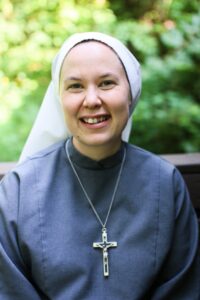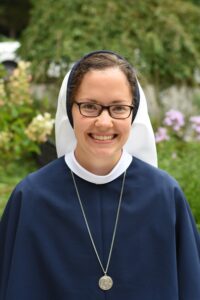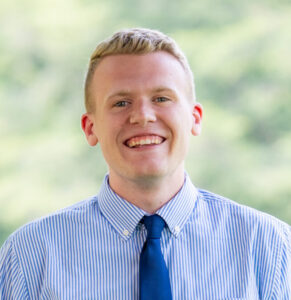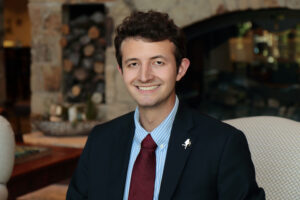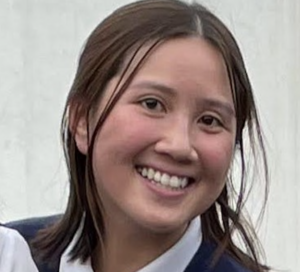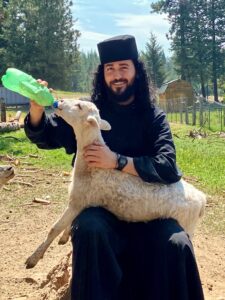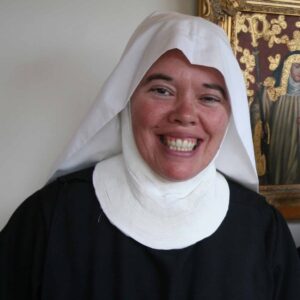“I realized that a calling to the contemplative life is really an invitation to begin participating in the joys of Heaven while still on earth …”
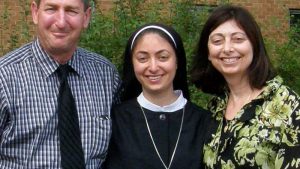 Sr. Miriam Esther
Sr. Miriam Esther
Solemnly Professed, Benedictines of Mary, Queen of Apostles
Kansas City, Missouri
When asked to describe my vocation journey, I always find it challenging, in part because it concerns such an intimate and personal matter, in part because my movement toward this decision, toward acceptance of this incredible privilege and grace, occurred almost imperceptibly, by gradual steps rather than in clearly defined stages. As the famous convert, Robert Hugh Benson, said in his autobiography, “you cannot trace the guidance of the Spirit of God or diagnose His operations in the secret rooms of your soul.” Nevertheless, I will do my best to outline the key events which helped me to recognize and embrace the call to the consecrated life.
As a young girl raised in an orthodox Catholic home, I grew up in wonderful familiarity with the lives of the saints and the riches of the Faith. I always understood the purpose of the religious life within the Mystical Body of the Church — to be a sign of the primacy of spiritual things and to save souls through prayer, penance, teaching, and example. My parents encouraged me to remain open to that calling. However, in those years, I regarded it primarily as a sacrifice which one hoped to escape, but accepted staunchly if required. On the one hand, I knew my life belonged to God and I resolved to put it at His disposal, but my inclination tended more toward the lay vocation.
After graduating from high school, I attended Christendom College with plans to leave after one year and pursue a more practical degree from a secular university. But, before long, the liberal arts — particularly philosophy and history — captivated my interest, so broadening and enriching my understanding of the Catholic tradition that I decided to stay and complete the Bachelor of Arts program there.
Through my philosophy classes, I discovered St. Thomas Aquinas’s account of human nature which provides a logical basis for the superiority of the contemplative life. I learned that man is a rational creature, whose highest powers are those of knowing and loving, powers only fulfilled and truly satisfied by the vision of Perfect Truth and intimate friendship with the Triune God. Thus, every man by his very nature pines for the Beatific Vision. I realized that a calling to the contemplative life is really an invitation to begin participating in the joys of Heaven while still on earth, by a life of special intimacy with Christ.
Through my history classes I learned also of the powerful spiritual force which monastic life wields over culture. In particular, I discovered the wisdom of the Benedictine Rule, how it enlivened and molded and preserved Christian culture from the early centuries of the Church. I grew to love the beauty and worthiness of the ideal, without experiencing a particular attraction towards it as a goal for my own life.
Soon after graduating and settling into a full-time job, I stumbled upon the website of the Benedictines of Mary, Queen of Apostles. I knew immediately that if I investigated the religious life, I would begin with their order. The description of their life was so inspiring and so satisfying to me; how uplifting, that in the heart of secular, modern America, a group of women order their lives entirely toward prayer, study of the divine mysteries and the service of priests! I visited their site often and began to pray earnestly concerning my vocation.
My desire for the consecrated life slowly grew. I felt as though the Lord was courting my soul, offering me a glimpse of the joys experienced by those who accept a loving union with Him through the consecrated life. Though I still appreciated the beauty of a lay vocation to marriage and family life, my heart was made captive to Love Himself. Eventually I wrote a letter to the Prioress, Reverend Mother Therese, expressing my interest. She encouraged me to visit and observe their life. However, after a brief correspondence, I suspended the application process — although my interest continued — daunted by the realization that my college loans might take years to repay entirely.
About a year later, still feeling strongly drawn toward the religious life, I broached the subject with my confessor. He advised me to pursue the religious life more seriously, recommending particularly that I investigate resources like the Mater Ecclesiae Fund for Vocations, renew correspondence with the Priory of Ephesus and make a visit. I began acquainting myself with the Benedictine Diurnal and finally made a visit to the convent in October of 2007, experiencing monastic life personally for about ten days.
The sisters have an icon of the Crucifixion with Our Lady and St. John at either hand of the Lord. They consider the icon an image of their charism, for they try to keep themselves present with Our Lady at the foot of the Cross, as vessels in Her hands, collecting the Precious Blood and Water flowing from the Pierced Heart of Christ and pouring out that grace and mercy upon His priests, who are the successors of St. John and the other Apostles. The rhythm of the monastic day establishes a prayerful, peaceful atmosphere. I discovered more profoundly the beauty of the Psalms, as we chanted eight times a day in the chapel. As my visit proceeded, I found that the words of Scripture, repeated again and again in public worship, begin to fill your mind and supply a vocabulary of love and praise for interior prayer as well. In addition to the periods of communal prayer and celebration of daily Mass, there was a fine library at the convent and time for lectio divina, spiritual reading or private meditation.
The sisters also spend many hours sewing vestments and altar cloths or preparing meals for priests who make use of their retreat facilities. At the start of any work, they pray a prayer consecrating their labor to Jesus through Our Lady. They work silently throughout the day, praying always for the priests of Holy Mother Church, who bear the awesome responsibility of administering the Sacraments through which Our Lord communicates life-giving grace to souls. In short, it was an altogether joyful and inspiring visit.
During the visit, I met with Mother Therese on two occasions. After enquiring into my impressions of the Priory and my understanding of monastic life, she encouraged me to pursue a vocation to the religious life. Soon after returning home, I made a request for entrance. Mother Therese graciously accepted my application and strongly encouraged me not to delay entrance, but rather to enter in June of 2008 if at all possible. It is my great hope and desire to join these sisters soon and, by renunciation of the world, to become an instrument always in readiness to serve Our Blessed Savior and His Church.

